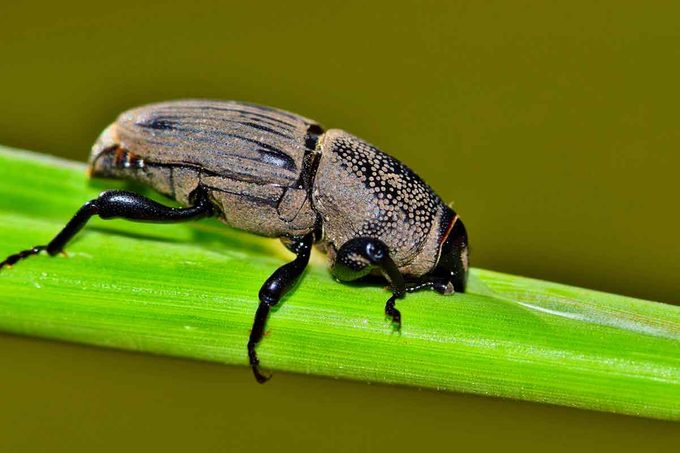If you have a turf lawn, you almost certainly have lawn grubs. These destructive pests are present during certain times of the year in most parts of the U.S.
Your healthy grass can sustain a little lawn grub damage and be OK. But when grubs proliferate, they can really wreak havoc. Take action before it’s too late. Read on to learn what you need to about lawn grubs, including how to prevent and eradicate them.
What Are Lawn Grubs?
Lawn grubs, or grub worms, are the white, c-shaped larvae of several types of beetles. They have brown heads and six legs at the front of their body. They range from a quarter-inch to two inches long and feed on the grass roots.
Past the larval stage, grub worms will form cocoons, or pupae, and emerge as billbugs or scarab beetles. They lie low for the winter. By springtime they’re ready to lay eggs, which become grubs, and the cycle continues.
Types of Lawn Grubs
Lawn grubs are billbug or scarab beetle larvae. Among billbugs, the most common types that infest lawns in the U.S. are:
- Hunting billbug, Sphenophorus venatus vestitus Chittenden;
- Bluegrass billbug, Sphenophorus parvulus Gyllenhal;
- Denver billbug, Sphenophorus cicatristriatus;
- Lesser billbug Sphenophorus minimus Hart;
- Unequal billbug Sphenophorus inaequalis.

There are 1,300 types of scarab beetles in the U.S., but not all of them are out to eat your lawn. The most common scarab beetles that attack American lawns are:
- Japanese beetle, Popillia japonica (an invasive);
- June beetle, Phyllophaga (includes dozens of species also called green June beetle, June bug or May beetle);
- Masked chafer, Cyclocephala borealis;
- Argentinian scarab, Cyclocephala signaticollis (invasive);
- African black beetle, Heteronychus arator (invasive);
- European chafer, Amphimallon majale (invasive).
How Grubs Impact the Lawn
Valerie Smith of Sod Solutions, which provides turfgrass for commercial and residential lawns, says, “Given the right opportunity and the appropriate amount of time, grub worms have the capability to completely destroy an entire lawn.”
Lawn grubs live underground and feed on the roots and thatch of grass. Grubs are typically dormant in the winter months, and do the most feeding — and damage — in spring and late summer. They especially thrive in southern climates, where there is no winter freeze to kill them off.
Left unchecked, a lawn grub infestation can weaken and kill sections of grass where the root system has been destroyed and the turf can no longer absorb water.
Signs of Lawn Grubs
According to the pros at Sod Solutions, here are some telltale signs of lawn grub problems:
- An increase in crows, raccoons and digging pests, like moles, in your lawn. They’re there to feed on the grubs.
- Weeds start to pop up due to weakened turf.
- Dying or damaged areas of grass.
- Spongey-feeling grass.
- Grass lifts up like a piece of carpet because its roots have died off.
Of course, another sure way to tell if you have grubs is to actually see them in your soil. Dig down three to four inches in several different sections of soil. An occasional grub is not cause for concern. But if you find more than five grub worms per square foot, Sod Solutions says it’s time for immediate treatment.
How to Get Rid of Lawn Grubs
In most climates, grubs are near the surface of the soil. They’re at their smallest and most vulnerable in August and September, so these are the best months to treat for them.
Sod Solutions recommends Dylox 6.2 Granular White Grub Insecticide, which needs to be applied with a broadcast spreader and watered within 24 hours. However, this product is toxic to wildlife, and shouldn’t enter storm drains or drainage ditches. For a natural pest solution, try one or more of these options:
- Introduce nematodes — beneficial, microscopic worms that feed on grub worms.
- Introduce milky spore, a naturally occurring “disease” that attacks grub worms but doesn’t harm other plants or wildlife. The spores must be spread several times over two years, but they protect your lawn for 10 years or more.
- Create a bird-friendly habitat by placing birdhouses and birdbaths in your yard to attract insect-eating birds like robins, wrens and jays. They’ll eat the grubs, along with the beetles once they start to emerge.
How to Prevent Lawn Grubs From Coming Back
A healthy lawn is the best defense against grub worms and beetles. Fertilize your lawn once or twice a year and remove built-up thatch. You may want to consider an organic lawn fertilizer, especially if you’ve introduced beneficial nematodes. Some chemical fertilizers will kill nematodes.
Should You Call a Professional?
If you already use a lawn service to keep your yard neat and healthy, they will likely spot your grub problem and suggest treatments. If not, you can call a lawn service to treat the lawn. But grub eradication is a doable DIY project. Pros are probably going to use the same methods you would if you treated the lawn yourself, so the only advantage of hiring a pro is to save yourself the hassle.
Article source here: What Are Lawn Grubs and How Do I Get Rid of Them?
Article source here:


No comments:
Post a Comment